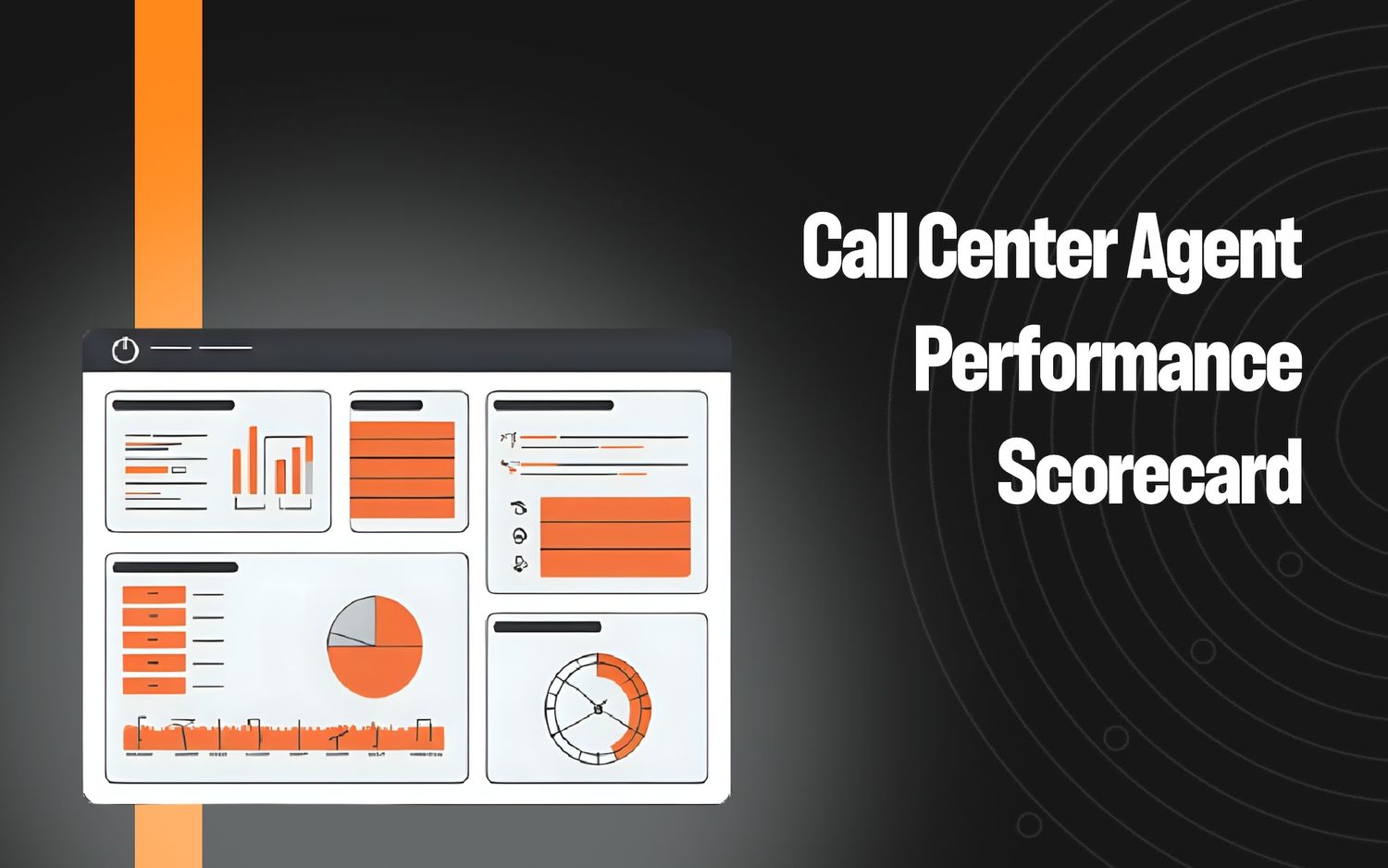Speech Analytics Software: In-Depth Comparison of 7 Options

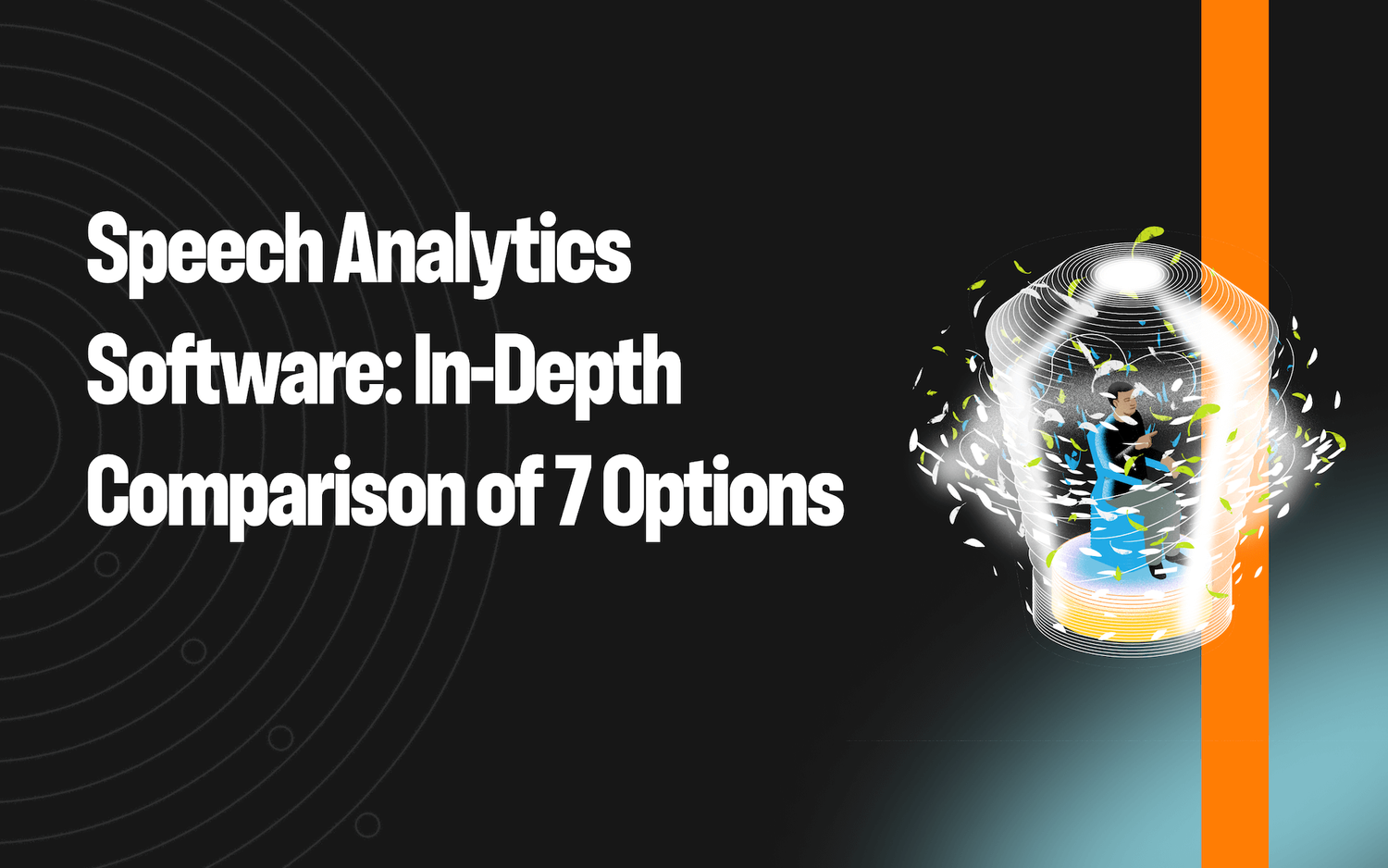
Speech analytics software refers to tools that use technology (and increasingly, artificial intelligence) to convert large volumes of speech data from customer interactions into actionable insights. The software distills unstructured calls, chats, text messages, and emails into useful data that provides meaningful business insights for understanding how to improve the customer experience.
Software that analyzes speech can automate significant portions of the evaluation process, covering 100% of interactions with greater accuracy. This extensive coverage — and on such a large scale �— allows you to identify patterns, address common issues, and provide targeted feedback to agents.
Speech analytics software solves many of the drawbacks of doing QA manually, including:
- Manual review overload: Countless hours are spent selecting and listening to call recordings, draining your time, and competing with other action items. You can only speed up or skip through so much before sacrificing accuracy in your review.
- Small sample sizes for evaluating performance: Only a small percentage of calls per agent (1–2%) are reviewed in a certain time frame. Calls chosen based on factors like duration or negative emotions may not represent overall agent performance.
- Limited survey data or customer feedback: Low response rates in traditional surveys don’t account for most customer sentiment. Also, the lack of detail in customer responses may leave out the true reasons behind their sentiment.
Below, we compare seven top speech analytics tools to help you find the best one for your needs. We start with Level AI — our own speech analytics platform — which incorporates natural language understanding and generative AI to provide deep and actionable insights about customer interactions.
1. Level AI
Speech Analytics Software That Comprehends Spoken Language
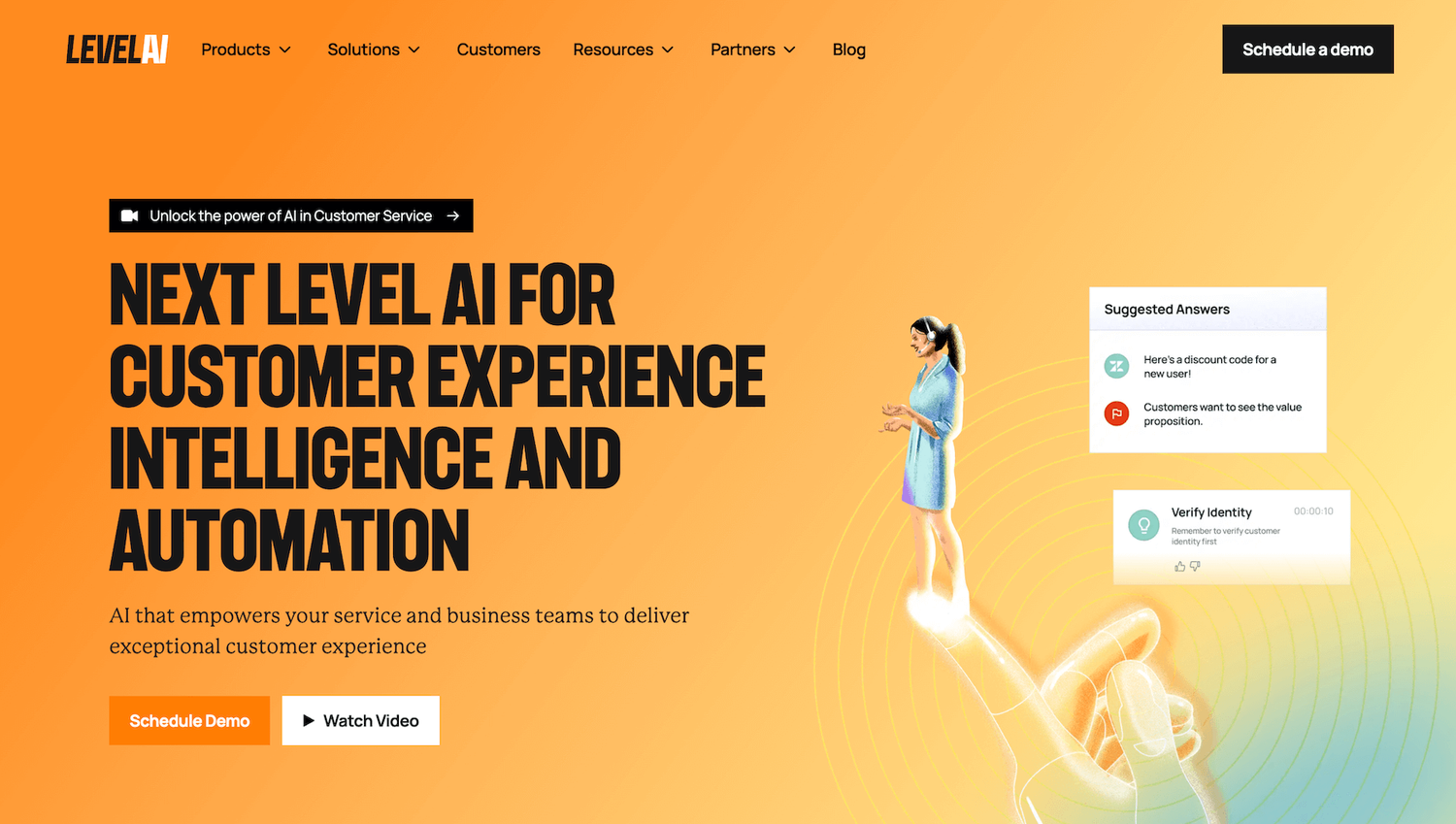
Unlike most speech analytics software that simply scans transcripts for keywords, Level AI recognizes the intents and sentiments expressed by agents and customers in conversation. This allows for more accurate labeling and organization of data.
Besides uncovering customer sentiment and intent, our speech analytics:
- Categorize the purpose and subject of calls based on the overall topic discussed (automatic dispositioning).
- Auto-score all customer conversations based on your rubrics.
- Generate an automatic summary of the contents of each call, and determine whether the customer’s issue was resolved (based on identified conversational moments).
- Assist with the setup of action items for coaching sessions, namely by identifying coaching opportunities among the total volume of support calls.
- Organize data into reports and dashboards to reveal Voice of the Customer (VoC) insights, letting you ask fascinating questions about what influences certain detected call trends.
Below, we dive deeper into these features to give you a better glimpse into how Level AI works.
Recognizing Intent with Semantic Intelligence
One reason for reviewing calls is to understand what was spoken during the call. Recognizing keywords is enormously helpful in this, but it’s sometimes not enough to understand why the customer picked up the phone to call support in the first place.
For instance, if a customer says “The battery won’t charge for some reason,” are they calling because they want a new battery, or are they inquiring about their product warranty?
A system that recognizes intent would analyze the entire conversation to detect the meanings underlying the words. Such a system would be contextually aware to the extent that keyword detection can’t be. Even to approach the semantic understanding that’s provided by natural language processing and AI, you’d need to enter tens or even hundreds of keywords around a single intent like “Warranty Inquiry.”
To this end, Level AI uses natural language understanding and a semantic intelligence model to parse conversations and instantly recognize intents expressed by both customers and agents. We refer to a recognized intent as a scenario and tag the phrases that hint at a scenario using conversation tags.
For example, we tag phrases like “The site keeps timing out,” and “I can’t load the product pages,” with conversation tags that both denote a scenario around Website Technical Issues.
You create your own business-specific scenarios and input some example phrases into each of these to train the AI to your specific circumstances:
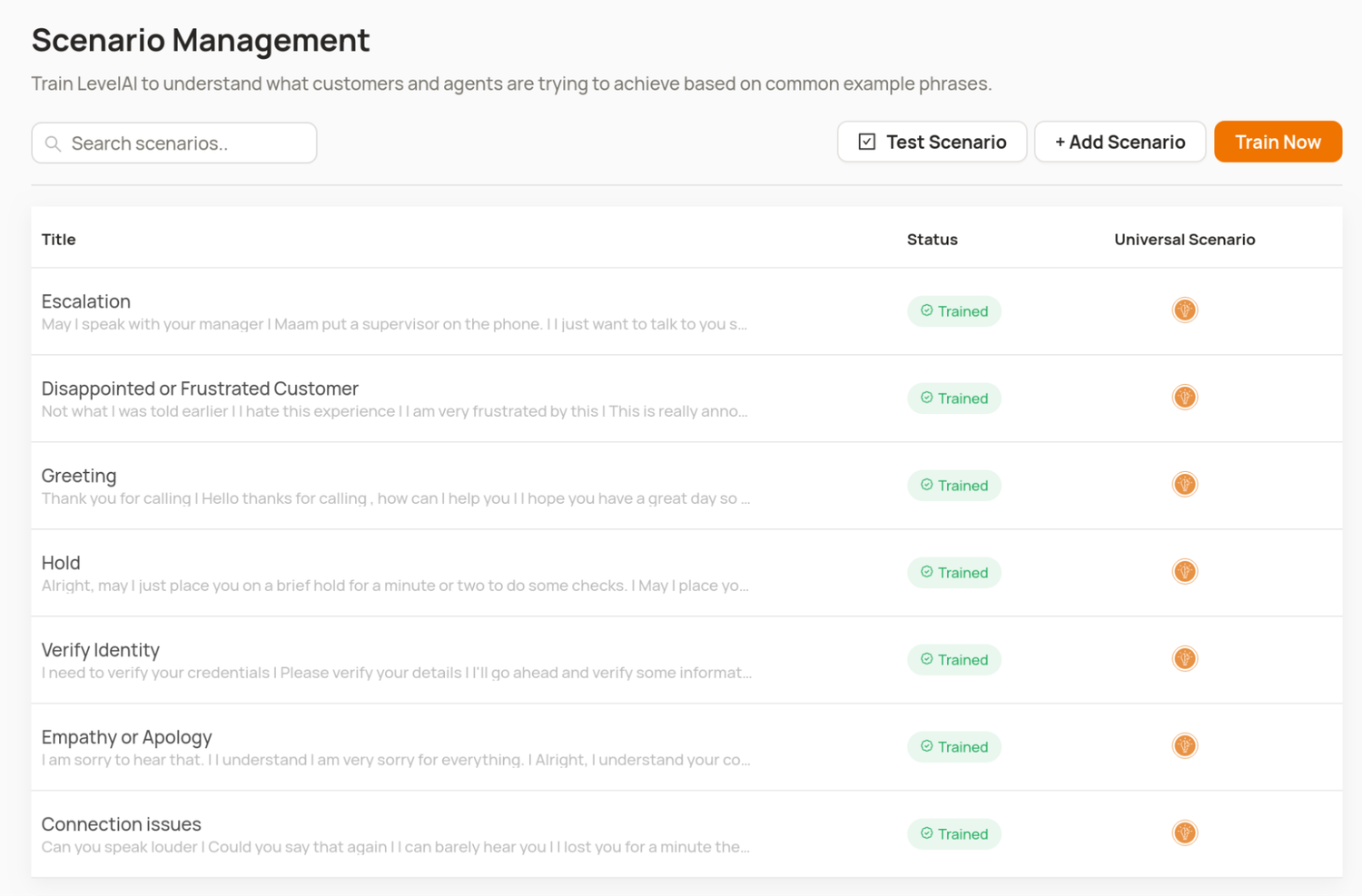
Our conversation tags are searchable and filterable to help you better identify and analyze specific conversations of interest:
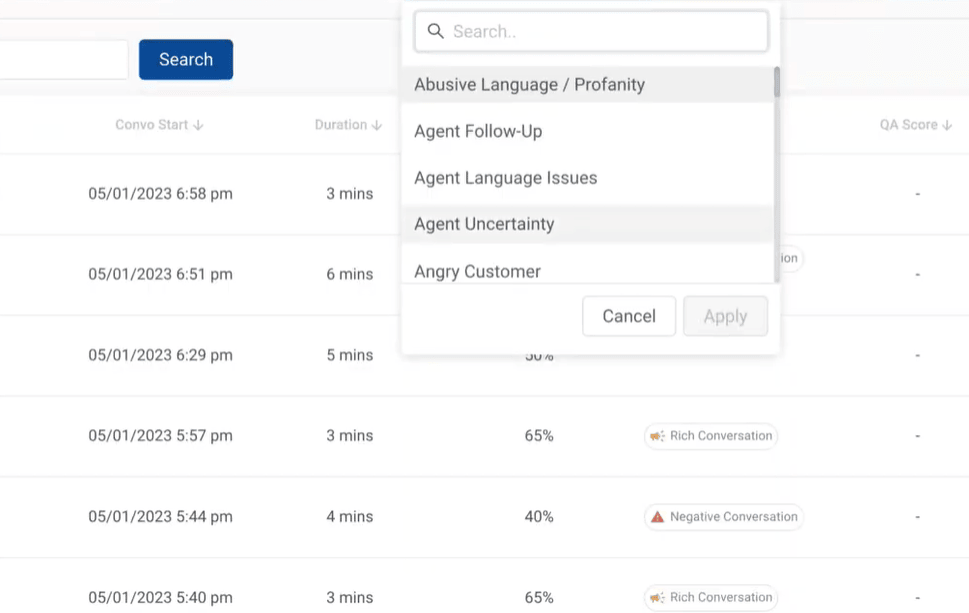
Categorizing Calls for Automatic Dispositioning
Our platform automatically categorizes calls for you, thanks to its natural language understanding of the topics and intents expressed during those calls. This saves your agents time and effort from having to manually find a matching category and subcategory after they get off the call.
This automatic dispositioning is more accurate than manual categorization by humans, as the latter is sometimes error-prone, especially when agents are tired and stressed after calls.
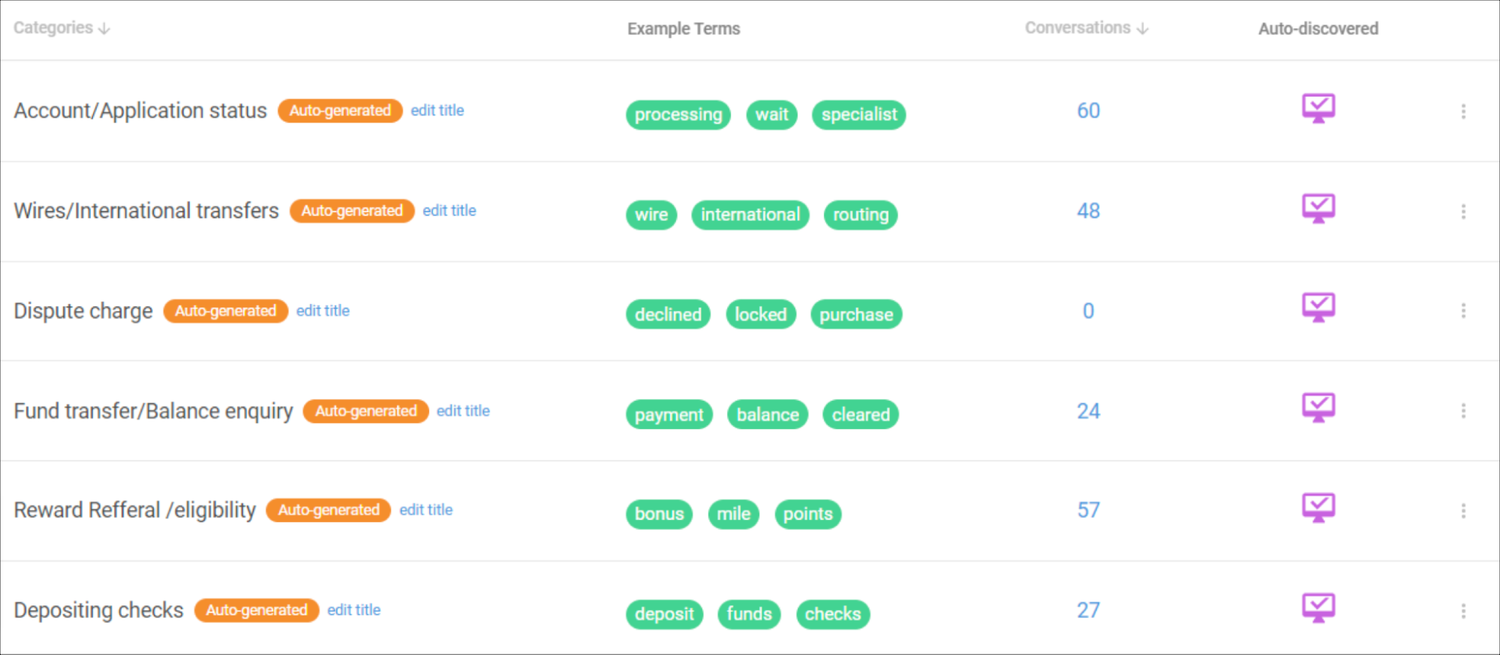
We also detect phrases that are closely related to a given category but, with the AI’s current understanding, don’t fully match it — we call these "near-miss" phrases. With each of these near-miss phrases, you have the option to include or exclude the phrase from the category. This fine-tunes the model for more accurate categorizations in the future.
Measuring Agent Performance with InstaScore
We auto score 100% of conversations so you can see at a glance how well an agent is performing, based on rubrics that can be quantitatively assessed, such as:
- Did the agent use the customer’s name during the conversation?
- Did the agent listen actively and empathetically to the customer’s concerns?
- Did the agent maintain a positive and professional tone throughout the call?
- Did the agent verify the customer’s information accurately?
Our system aggregates all the data into a singular InstaScore (expressed as a percentage) for a support conversation:
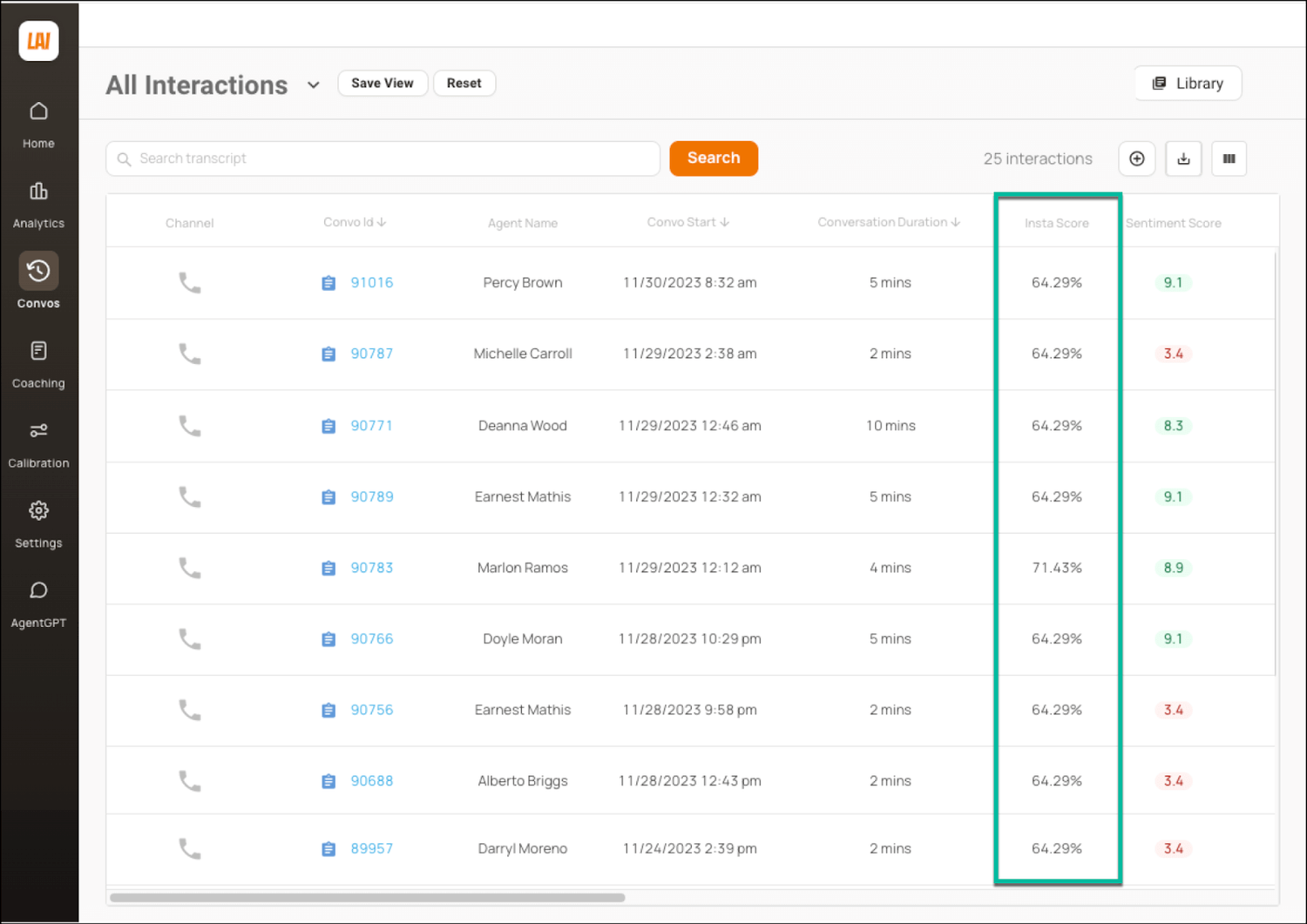
InstaScore basically auto scores all conversations — without bias — so you can more efficiently sample those requiring your attention.
For example, InstaScore shows you both low- and high-performing agents at a glance.
By automating all of the quantitative aspects of grading conversations, managers and QA staff can focus on identifying and coaching for qualitative aspects such as problem-solving skills, communication effectiveness, and adherence to company policies.
Auto Summarizing Calls with Smart Summary
To help you understand at a glance what a call was about and whether its issue was resolved, we display a short summary for each call containing key facts, including:
- The primary reason for the conversation
- Actions taken by the agent
- Overall resolution
- Follow-up actions
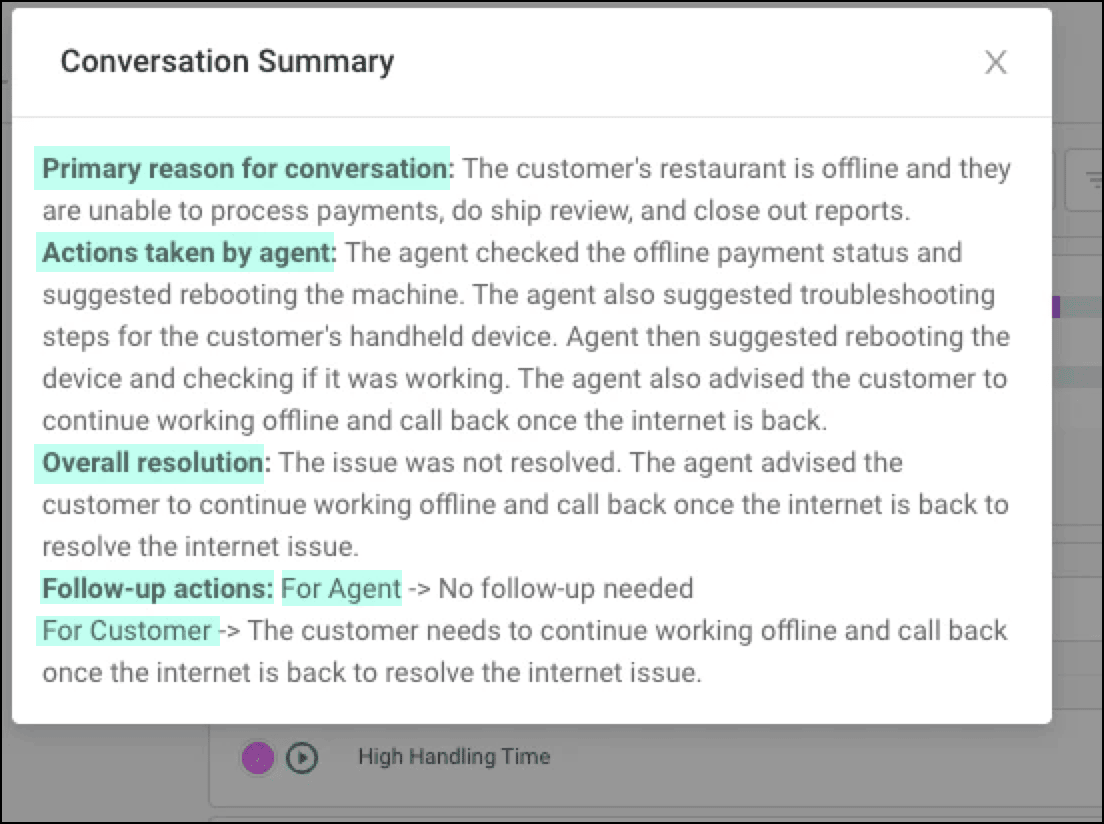
These automated, concise summaries help you better prioritize calls requiring further attention, such as those with unresolved issues or those that deviate from standard procedures.
Identifying Coaching Opportunities
InstaReview indicates problematic calls at a glance, giving you the opportunity to follow up with training and coaching. It’s especially useful for quickly identifying interactions that fall short of performance standards and areas where agents may need additional support or guidance.
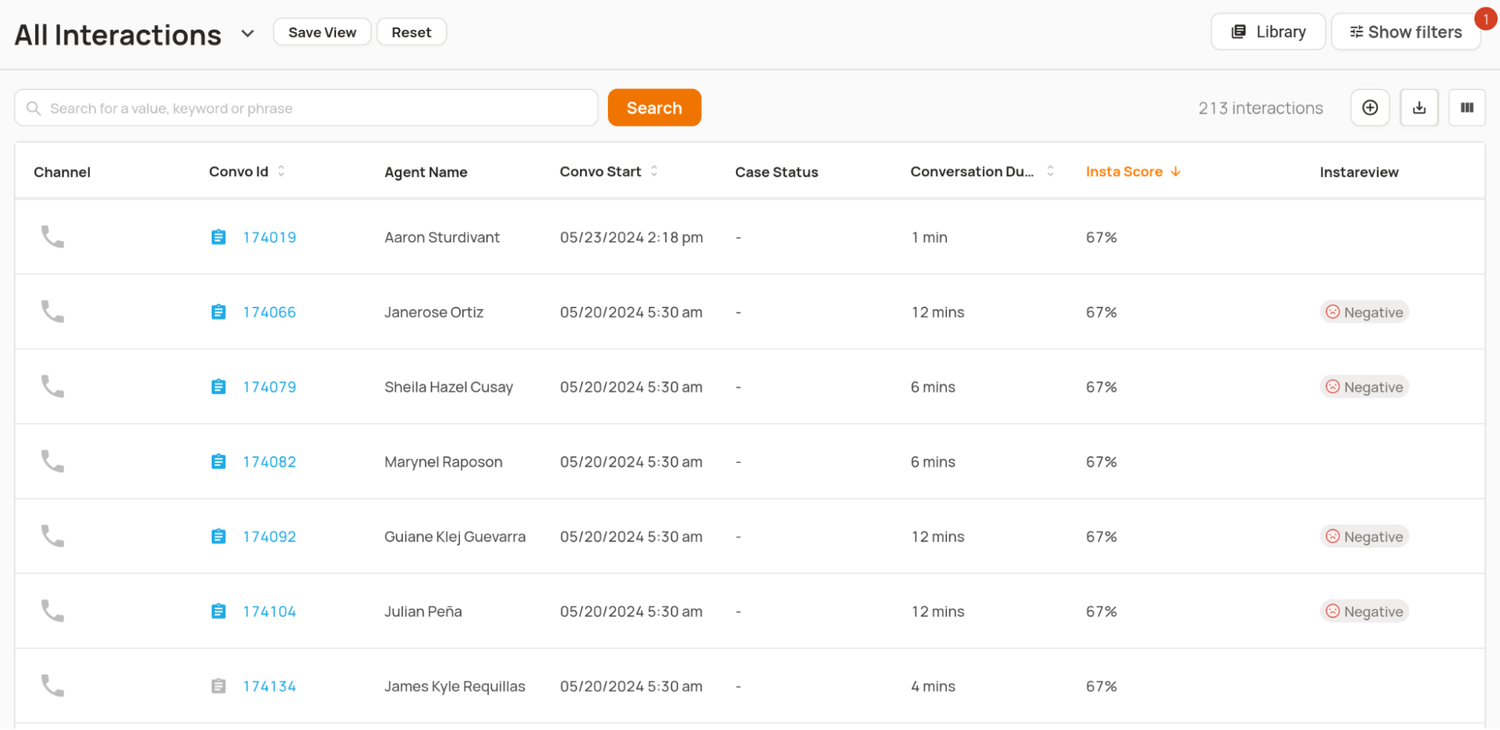
This is a more effective way to judge which calls are coachable than randomly sampling longer-than-usual customer calls and listening for agent errors.
Besides InstaReview, Level AI also offers dedicated coaching workspaces for initiating and administering coaching and training sessions. Conversation data is also shareable with agents to give them more direct feedback on their performance.
Scoring Conversations for Sentiment
Determining the aggregate sentiment of a call is tricky because different sentiments can be expressed throughout. For instance, one person may be feeling disappointed when they call in, only to become elated in the middle of the call, and finally feel a little frustrated by the end.
Our platform measures the overall sentiment or feeling throughout a conversation by calculating weightings based on when a given sentiment was expressed. The highest weighting is given to sentiments expressed after a potential resolution because this often reflects the lasting impression of a customer’s experience.
Using these weightings, the Sentiment Score results in a number between 0 and 10 (with 0 being strongly negative and 10 being strongly positive), which represents a holistic measurement of the customer’s overall experience during the conversation.

This highlights yet another advantage of Level AI’s sentiment analysis: while we analyze words and their meanings to detect expressed sentiments, other products in the space identify sentiments merely from changes in pitch and tone.
While this often signals changes in emotion, we find it fails to fully capture the context and nuance of the conversation, leading to a less accurate understanding of customer sentiment and intent.
We also tag text within conversations with sentiment tags that indicate emotional moments. These are searchable and filterable, and provide a reporting dimension that allows you to associate particular sentiments with call outcomes, for instance.
Uncovering Hidden Customer Insights with Voice of the Customer Metrics
VoC data is generally collected via customer surveys that present a few challenges, namely that contact center agents don’t always send these out after a call, and customers don’t always answer them.
If they do answer, feedback may be skewed towards more extreme positive or negative sentiments, missing the nuanced middle ground that provides valuable insights and represents the majority of customer experiences.
Sometimes, VoC data is also collected through word clouds that capture the frequency of specific keywords mentioned during conversations. Unfortunately, this gives false and incomplete insights into VoC because customers don’t always talk about what they need during interactions. They may also mention a few things that aren’t shown in the word cloud.
Level AI gathers VoC data by analyzing all customer interactions across your support channels (without relying on survey responses), ensuring that every voice is heard. This provides a highly accurate and timely picture of customer experience.
We provide more thorough reporting on typical VoC metrics like CSAT, NPS, and customer effort and detect and highlight recurring patterns you didn’t know to look for.
These patterns are shown in our VoC dashboard:
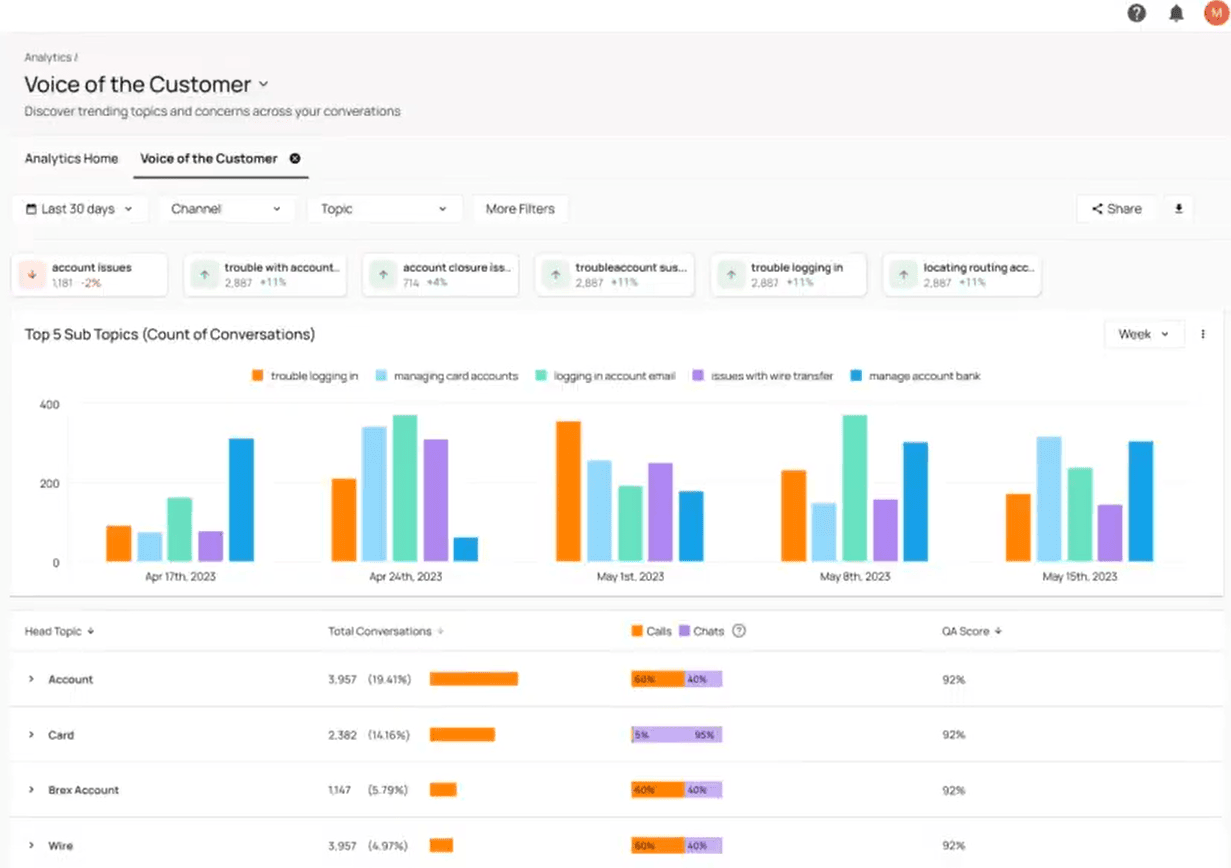
The automatic flagging of such previously unknown insights, which sometimes manifest as the root causes of customer issues, lets you proactively identify and get ahead of problems.
Flexible Reporting and Analytics
Our platform offers ready-to-use speech analytics right out of the box (e.g., conversation dashboards showing associated metrics like InstaScore, scenarios and conversation tags, and sentiment analysis), but you can create your own dashboards according to your needs.
Level AI lets you pull and query data from the platform itself or from external sources like your ticketing system, CRM, other analytics software, etc. This lets you combine different data types and reporting dimensions in a variety of ways, to ask questions like:
- What conversational trends are leading to these CSAT scores?
- What are the main reasons for customer churn, as indicated by interaction data?
- Are there specific times of day or week when customer interactions tend to be more positive or negative?
- How effective are recent changes in customer service protocols based on sentiment analysis?
To create your own reports, our Query Builder lets you assemble data from disparate sources into unique dashboards:
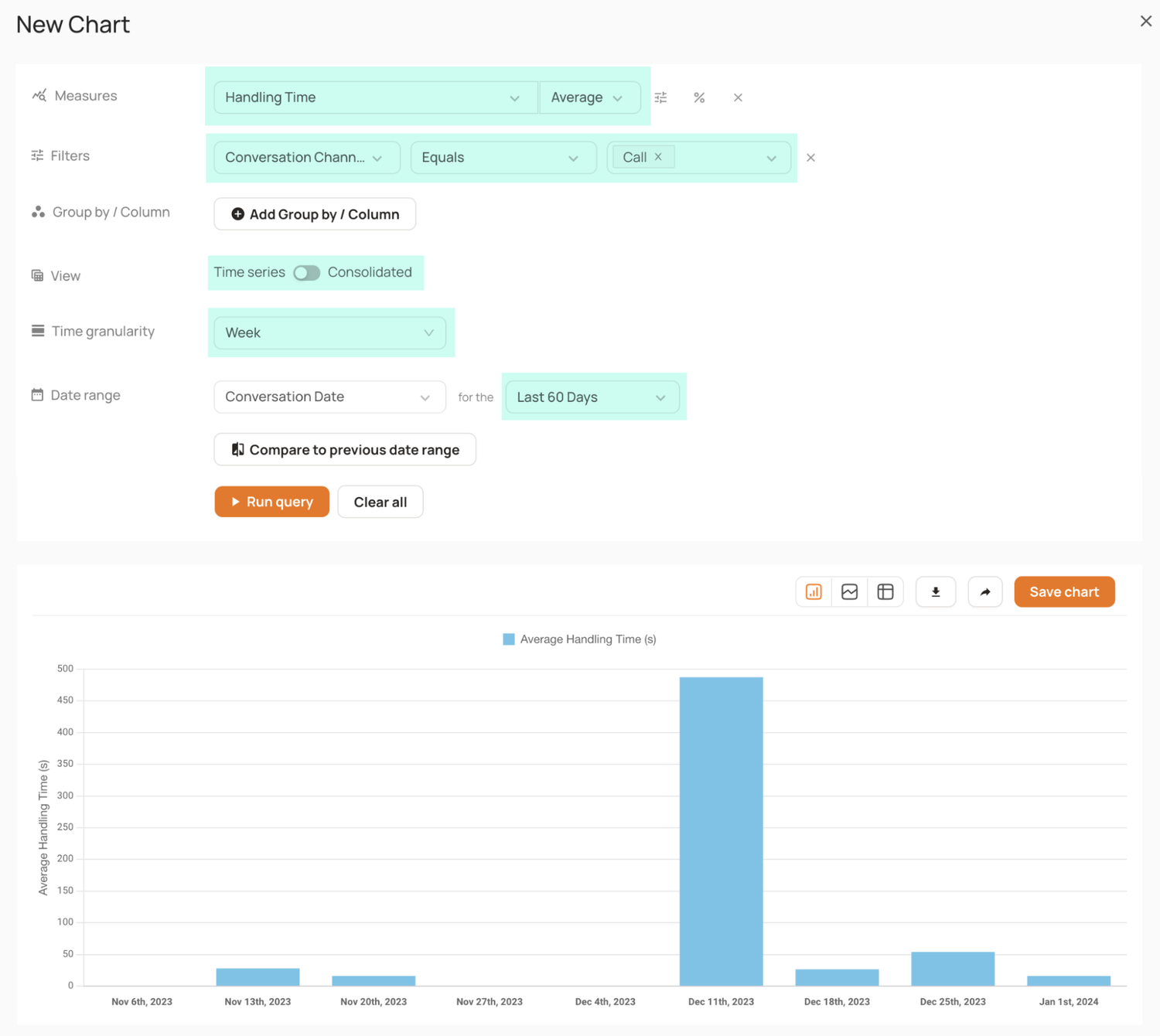
You can report against a variety of Level AI data, such as categories, conversation tags, sentiment tags, scenarios, VoC metrics, negative metrics, and more:
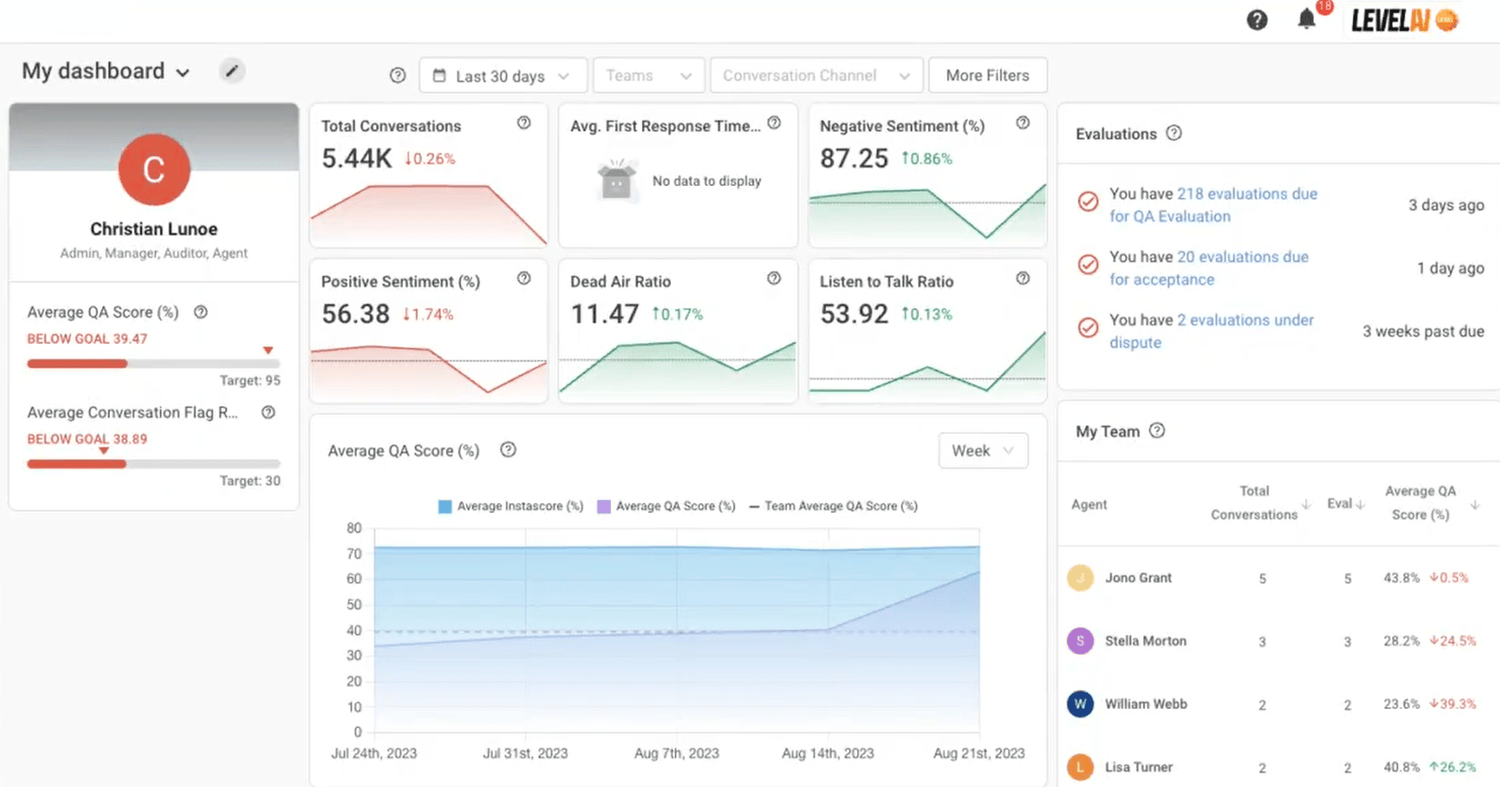
Book a Free Demo with Level AI
This was just a quick summary of how Level AI can help QA staff and call center managers reach new levels of operational efficiency and elevate the customer experience.
Book a free demo to see how AI speech analytics can provide your team with deep insights into customer interactions.
2. Observe.AI
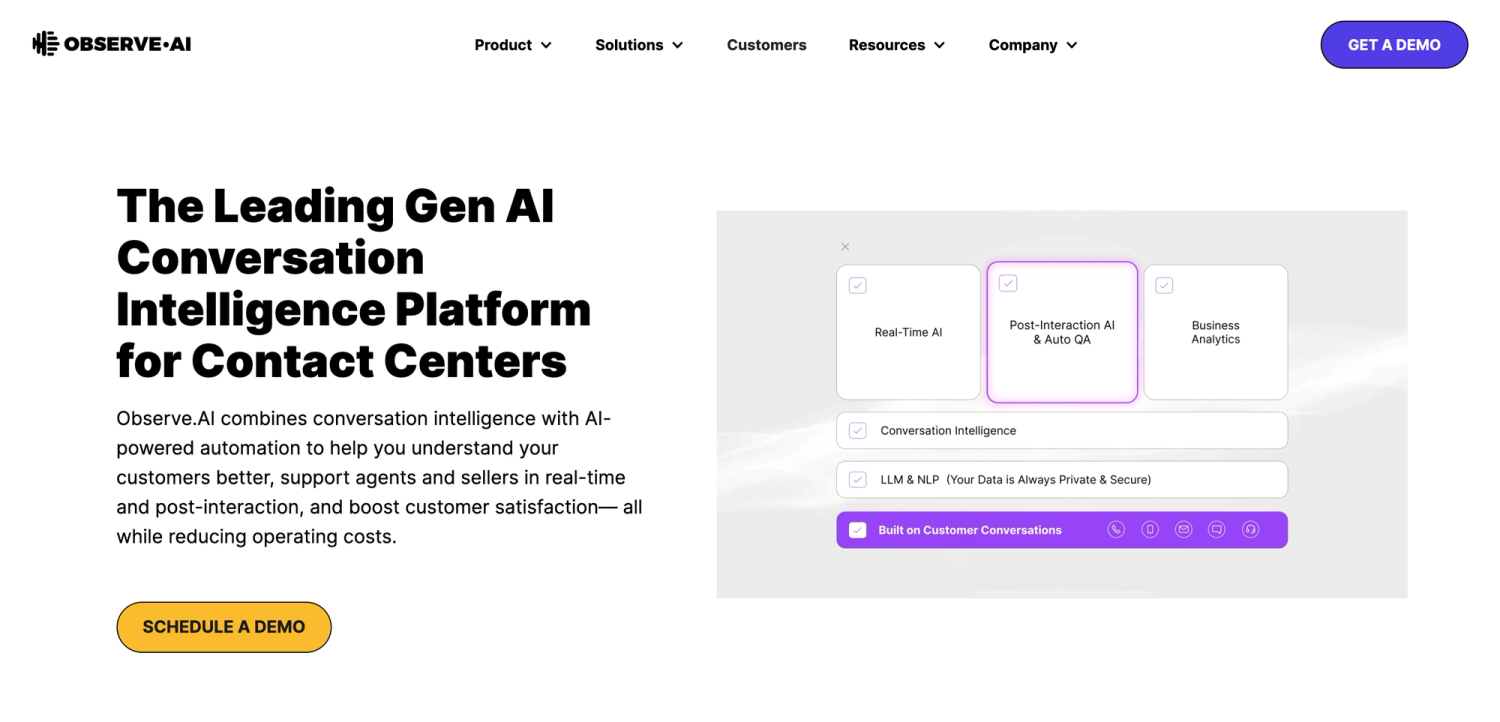
Observe.AI offers AI-driven analytics to help you better understand your customers. Their features fall into three main categories: real-time AI, post-interaction AI, and advanced business analytics.
Within these three categories, their features include:
- Conversation Intelligence: Analyzes unstructured customer interactions across support channels, providing visibility into ongoing issues.
- Post-Interaction AI: Automates and scales quality assurance while offering personalized coaching for continuous improvement.
- Reporting and Analytics: Analyzes VoC metrics and broader business KPIs across customer success, sales, and other areas.
- Integrations: Connects with various external systems, whether on-premises or in the cloud.
According to Observe.AI’s website, they offer pricing based on the specifics of their customers’ business. You’re invited to participate in a demo to get more information.
3. Tethr
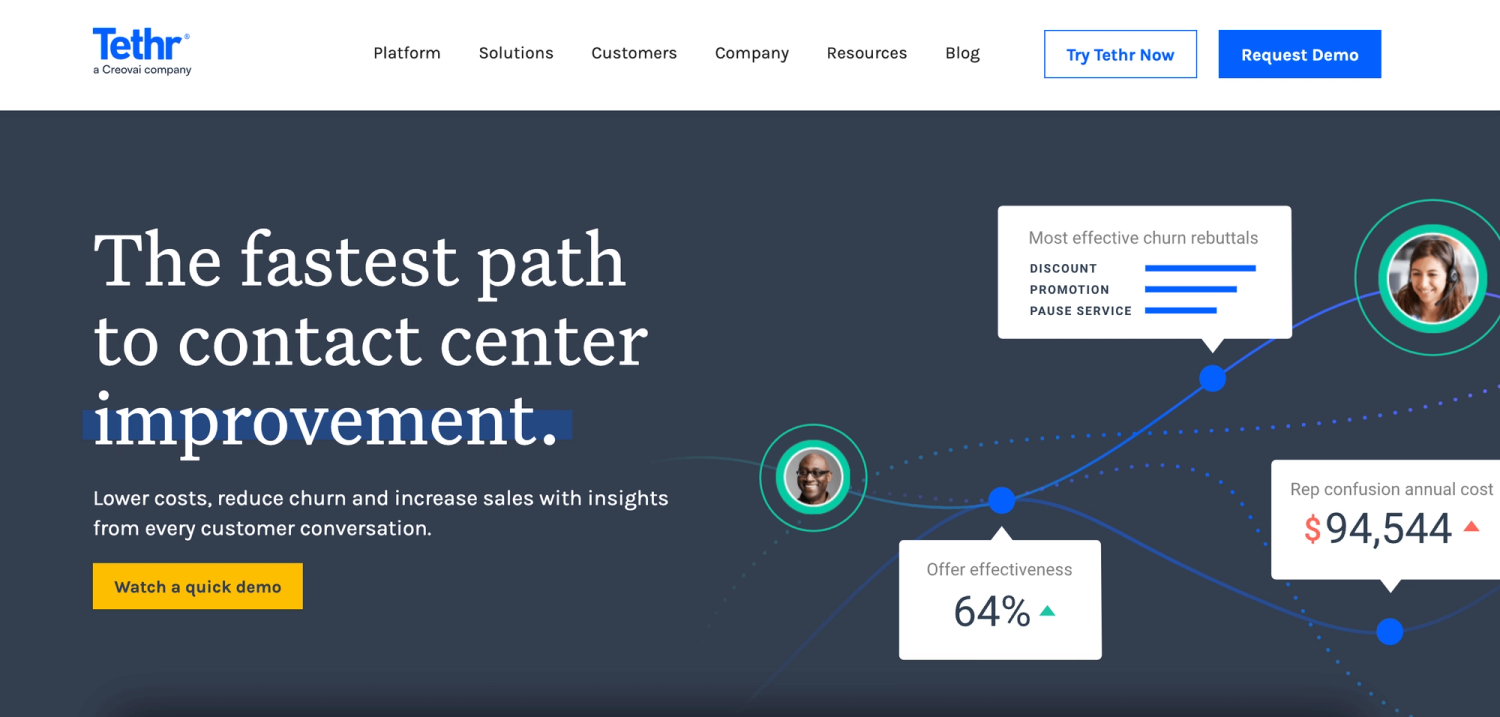
Tethr is known for its Tethr Effort Index (TEI), a unique metric designed to measure the customer effort involved in each interaction. By quantifying the effort a customer exerts, the TEI serves as a strong predictor of customer loyalty and provides insights that can help optimize customer satisfaction and retention strategies.
Tethr offers the following features:
- TEI: Utilizes 250 independent variables and over 10k keywords.
- CSATai: Predicts customer satisfaction scores from conversations, removing the need for CSAT surveys.
- Custom Scoring Configurations: Tailored to meet specific customer needs.
Tethr doesn't list pricing on their website; you must book a demo for a quote.
4. Enthu.AI
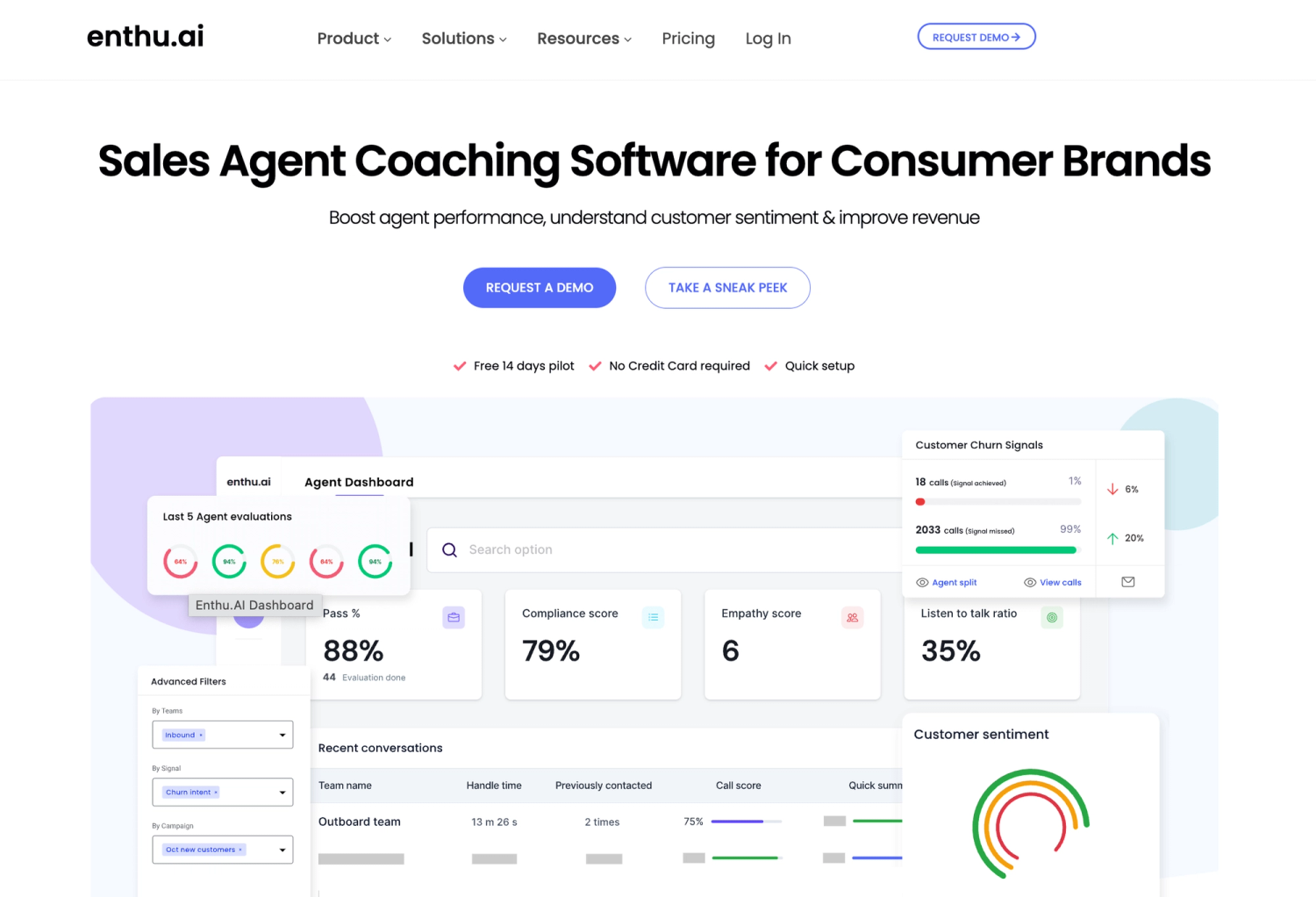
Enthu.AI’s strength is that it spots keywords that indicate a customer's interest in a product or service that the agent might not have addressed. It’s primarily designed for agent sales coaching for consumer brands, helping them to achieve higher closing rates.
Enthu’s features include:
- Call QA: Provides quality monitoring across your organization, including 100% coverage and analysis of key call moments.
- Security Features: Includes PII redaction, IP whitelisting, enterprise encryption, and more.
- Advanced Features: Offers call transcript downloads, call ignores, speaker labels, and caller history.
- Custom Configurations: Allows for defining critical call moments, creating customized evaluation forms, and setting up organization-specific notifications.
Although Enthu doesn’t disclose pricing, their website indicates that pricing depends on number of seats, and whether the product’s features are powered by AI or not.
5. CallMiner
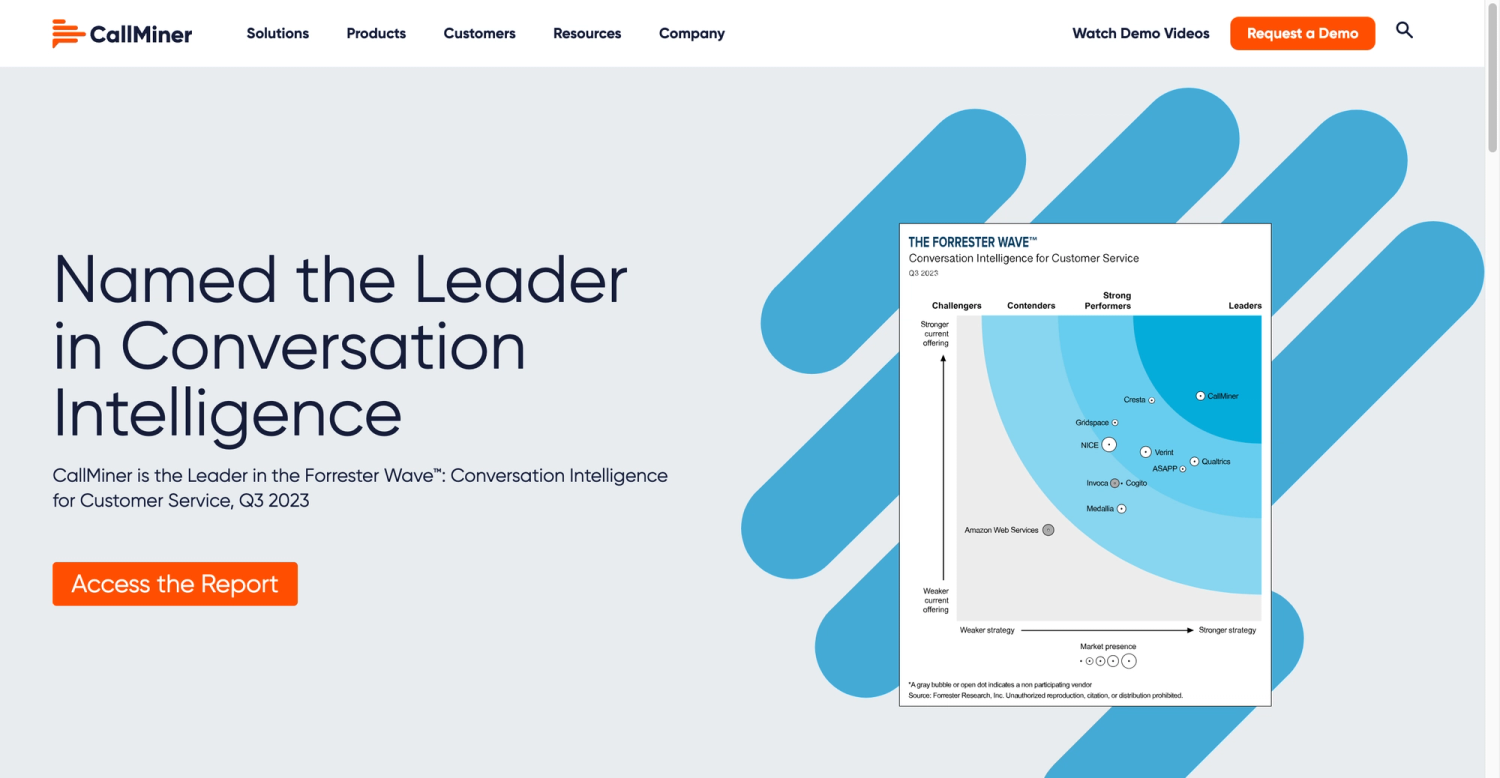
CallMiner is a conversation analytics platform that analyzes conversations across different support channels. They boast a comprehensive Solution Catalogue with industry-specific pre-built configurations for the healthcare, finance, or retail sectors (among others).
Their Eureka product offers speech recognition features to help transcribe, analyze, and understand customer interactions.
Eureka’s features include:
- Speech-to-Text Capture: Converts audio interactions into text for further analysis.
- Transcription & Acoustic Measurements: Provides insights into customer emotions.
- Machine Learning Solutions: Analyzes words and phrases from conversations.
- Automated Scoring: Offers quick assessments of conversations.
CallMiner doesn’t disclose pricing on their website; you can contact their team for a custom quote.
6. Verint
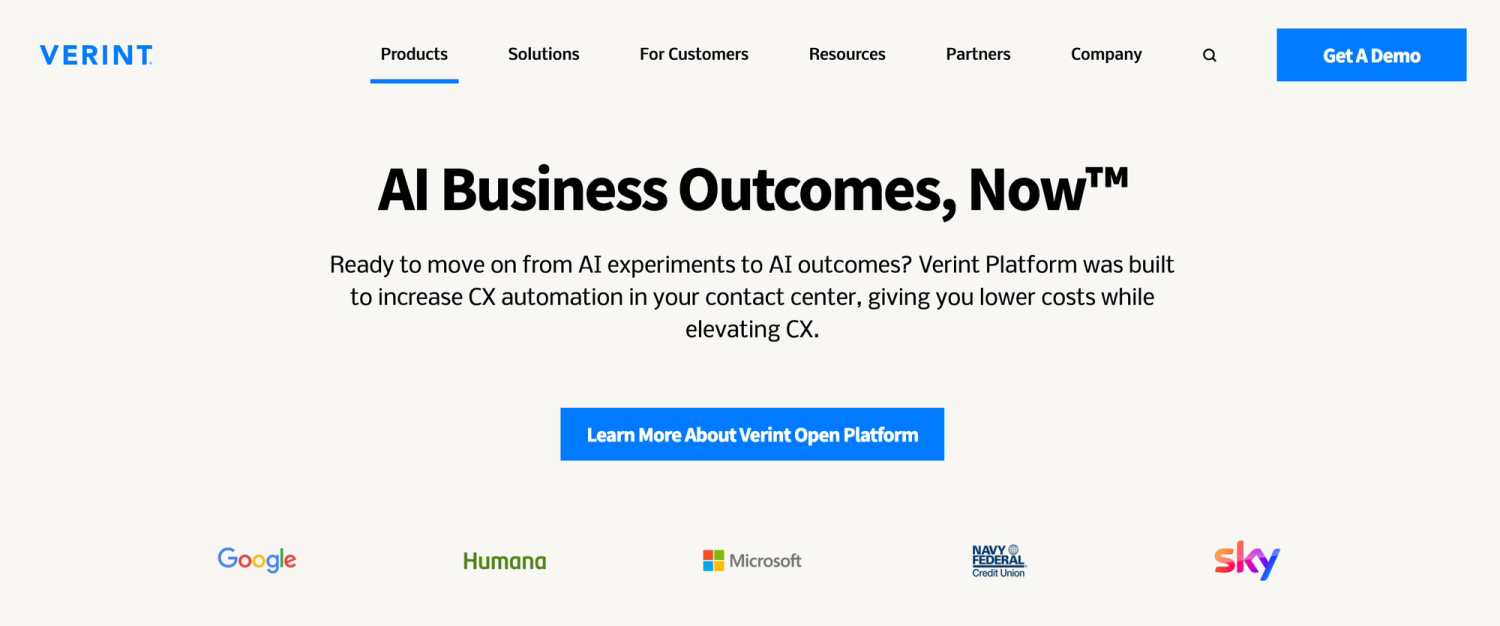
Verint caters specifically to large enterprises that have high-volume contact centers and intricate operations. Their customization enables enterprises to consolidate multiple functionalities into one platform, streamlining workflows and reducing reliance on siloed solutions.
The platform offers features that include:
- Analysis of Unstructured Data: Reveals anomalies and sentiment across support channels.
- Workforce Tools (“Bots”): Provides insights like call risk scoring and PII redaction.
- AI-Powered Transcription and Speech Processing: Identifies root causes and emerging trends.
- Dashboards: Combine call transcripts, sentiment analysis, and screen recording tags.
Verint doesn’t disclose pricing on their website, but you’re invited to demo their product for more information.
7. Qualtrics
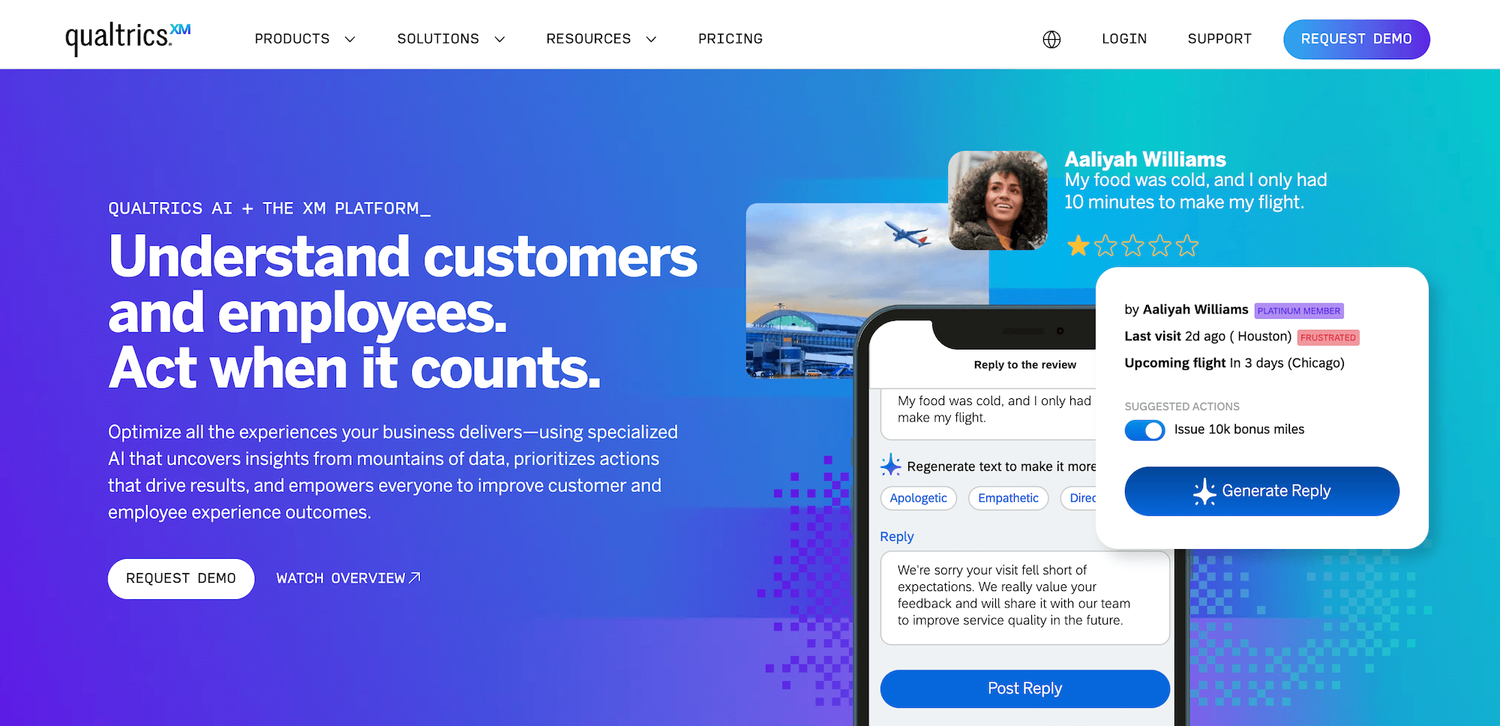
While not purely a speech analytics solution, Qualtrics integrates well with speech data and offers strong survey and experience management functionalities. This makes it a particularly suitable option for businesses that already use Qualtrics and are seeking to add conversation analytics as another way to understand customer sentiment.
Qualtrics integrates speech analytics into its Experience Management (XM) Platform, allowing you to analyze voice data alongside surveys, feedback forms, business intelligence, and social media mentions for a comprehensive view of the customer journey.
Qualtrics’ pricing is determined by the modules that customers request, such as XM for Customer Experience, Employee Experience, and Strategy & Research.
Getting Started
The Level AI platform leverages sophisticated natural language processing models and semantic intelligence to analyze speech and achieve conversational intelligence. It automatically assesses the content and quality of 100% of support interactions, uncovering patterns and identifying larger trends.
To get started, schedule a free demo to see for yourself how conversational intelligence with Level AI works and learn how it delivers actionable insights to your organization.
Keep reading
View all

